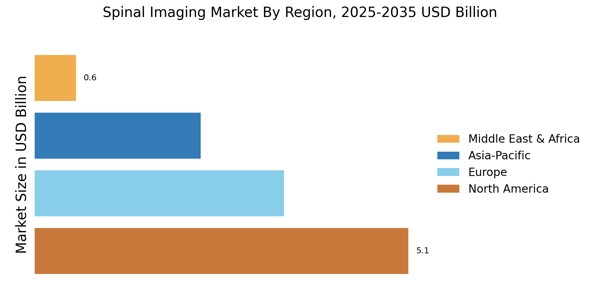Focus on Preventive Healthcare
The Spinal Imaging Market is benefiting from a growing emphasis on preventive healthcare measures. As healthcare systems shift towards proactive management of spinal health, there is an increasing demand for imaging services that facilitate early diagnosis and intervention. Preventive imaging can help identify potential spinal issues before they escalate into more severe conditions, thereby reducing the overall healthcare burden. This trend is reflected in the rising investments in imaging technologies and services aimed at enhancing preventive care. The Spinal Imaging Market is likely to expand as healthcare providers prioritize preventive strategies, leading to increased utilization of advanced imaging modalities.
Rising Incidence of Spinal Disorders
The prevalence of spinal disorders is on the rise, significantly impacting the Spinal Imaging Market. Conditions such as herniated discs, spinal stenosis, and degenerative disc disease are becoming increasingly common, particularly among aging populations. Recent statistics indicate that nearly 80% of individuals will experience back pain at some point in their lives, leading to a heightened need for effective diagnostic imaging. This surge in spinal disorders necessitates advanced imaging techniques to accurately assess and manage these conditions. Consequently, the Spinal Imaging Market is poised for growth as healthcare providers seek to implement comprehensive imaging solutions to address the growing burden of spinal health issues.
Integration of Telemedicine in Imaging Services
The integration of telemedicine into imaging services is emerging as a transformative factor in the Spinal Imaging Market. Telemedicine facilitates remote consultations and follow-ups, allowing patients to access imaging services without the need for in-person visits. This trend is particularly beneficial for individuals in rural or underserved areas, where access to specialized spinal imaging may be limited. The convenience and efficiency of telemedicine are likely to drive increased demand for imaging services, as patients seek timely diagnoses and treatment options. As telemedicine continues to evolve, the Spinal Imaging Market is expected to adapt, potentially leading to enhanced patient engagement and improved healthcare outcomes.
Technological Advancements in Imaging Techniques
The Spinal Imaging Market is experiencing a notable transformation due to rapid technological advancements. Innovations such as high-resolution MRI and CT imaging are enhancing diagnostic accuracy, allowing for earlier detection of spinal disorders. The integration of artificial intelligence in imaging analysis is streamlining workflows and improving patient outcomes. According to recent data, the market for advanced imaging technologies is projected to grow at a compound annual growth rate of approximately 7.5% over the next five years. This growth is driven by the increasing demand for precise imaging modalities that can provide detailed insights into spinal health. As healthcare providers adopt these advanced technologies, the Spinal Imaging Market is likely to witness a surge in demand for sophisticated imaging solutions.
Aging Population and Increased Healthcare Expenditure
The aging population is a significant driver of growth in the Spinal Imaging Market. As individuals age, the likelihood of developing spinal disorders increases, necessitating advanced imaging for diagnosis and treatment planning. Furthermore, rising healthcare expenditure in many regions is facilitating access to state-of-the-art imaging technologies. According to recent reports, healthcare spending is expected to rise by 5% annually, which will likely enhance the availability of advanced spinal imaging services. This trend indicates that the Spinal Imaging Market will continue to thrive as healthcare systems adapt to the needs of an aging demographic, ensuring that effective imaging solutions are readily available.


















Leave a Comment